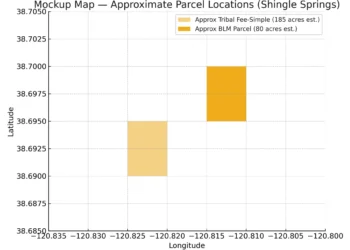El Dorado County (March 22, 2024) – Cannabis Cultivation Sparks Tension Among Somerset Wine Growers
[SOURCE – Information VIA CBS News] In the picturesque landscapes of Somerset, El Dorado County, a clash between tradition and progress has emerged, as local wine growers find themselves at odds with the burgeoning cannabis industry. Randy Rossi, the proprietor of Saluti Cellars, has spent a quarter-century cultivating grapes and crafting fine wines amidst the serene backdrop of the Fairplay American Viticultural Area. Yet, Rossi and his cohorts are now grappling with a new reality – the encroachment of cannabis cultivation into their cherished domain.
The crux of the issue lies in a recent decision by El Dorado County authorities to greenlight a seven-acre cannabis project on Perry Creek Road, much to the chagrin of Rossi and fellow wine enthusiasts. Expressing vehement opposition, Rossi underscores the potential ramifications on their hard-earned brand, citing safety concerns and the specter of prolonged water scarcity exacerbated by the voracious water demands of cannabis plants.
El Dorado County officials, however, defend their stance, highlighting the rigorous scrutiny applied to all cannabis-related endeavors under the county’s ordinance, particularly since its bolstering in 2019. Chris Perry, the county’s assistant director of planning, elucidates the multifaceted review process involving various stakeholders, ensuring compliance with stringent regulations aimed at safeguarding environmental and community interests.
Nevertheless, Rossi remains undeterred, rallying fellow vintners in a concerted effort to challenge what they perceive as an existential threat to their livelihoods. The looming specter of economic losses looms large, prompting wine growers to intensify their advocacy efforts, demanding a reevaluation of the prevailing cannabis ordinances.
Amidst this simmering conflict, the Perry Creek Cannabis Project stands as a focal point of contention. While the project proponents maintain their commitment to responsible farming practices and environmental stewardship, dissenting voices persist, echoing concerns over odor, water usage, and chemical contamination.
In a detailed response provided to CBS13.com, the Perry Creek Road applicant offers a robust defense of their intentions, emphasizing their track record of sustainable farming practices and proactive measures to mitigate potential adverse effects. They contend that cannabis cultivation represents a promising avenue for economic revitalization in El Dorado County, aligning with the county’s broader agricultural policy objectives.
As the debate rages on, the fate of Somerset’s pastoral landscape hangs in the balance, with stakeholders on both sides vying for recognition and legitimacy in a rapidly evolving agrarian milieu. With the option of appealing the county’s decision looming, the stage is set for a protracted legal battle, underscoring the profound implications of this clash between tradition and innovation in one of California’s most idyllic enclaves.
Cannabis vs. Grape Water Usage: A Clarification Amidst Somerset Controversy
[SOURCE – Information VIA Lee Tannenbaum] In the midst of the heated debate swirling around cannabis cultivation encroaching upon the idyllic landscapes of Somerset in El Dorado County, a critical aspect has come under scrutiny – water usage. Recent reporting has purported a staggering tenfold disparity between the water consumption of cannabis plants versus grape vines, sparking consternation among stakeholders. However, upon closer examination and diligent fact-checking, it becomes evident that the figures presented may not accurately reflect reality.
Contrary to the initially reported claim, cannabis plants do not consume ten times the water of grape vines. In fact, according to meticulously gathered data, a mature grape vine demands approximately 8 to 10 gallons (30.3 to 37.9 liters) of water per day, while a single cannabis plant averages around 5.5 gallons per day seasonally. When extrapolated to an acreage scale, the disparity in daily water usage becomes more nuanced.
Taking into account the typical planting densities for both crops, with grape vines spaced at 6 feet intervals with 8 feet rows and cannabis plants typically spaced at 8 to 10 feet intervals with corresponding rows, the comparative water consumption per acre per day yields intriguing results. An acre of grapes, with an average of 907 plants, consumes approximately 8163 gallons of water per day, assuming an average water usage from the provided range. Conversely, an acre of cannabis, accommodating 450 to 600 plants, translates to approximately 2887 gallons of water per day.
This recalibration of water usage statistics not only refutes the previously disseminated notion of a tenfold discrepancy but also underscores the importance of accurate reporting in fostering informed discourse. Additionally, it’s crucial to note that while El Dorado County permits a maximum of two acres of cannabis cultivation per property, there exists no such limitation on grape vines.
Furthermore, it’s imperative to consider the geological realities of water sourcing in El Dorado County. Wells primarily tap into rock fractures rather than traditional aquifers, amplifying concerns over water scarcity and sustainable usage practices.
Amidst this complex landscape of competing interests, responsible journalism necessitates a commitment to factual accuracy and thorough research. As the contentious debate over land use and agricultural priorities continues to unfold, clarity and precision must guide the discourse, ensuring that all stakeholders are equipped with the knowledge necessary to make informed decisions for the future of Somerset and its agricultural heritage.









